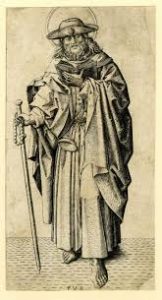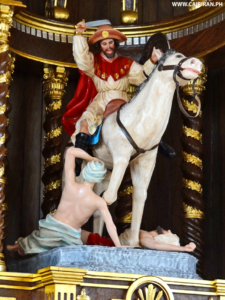James, a fisherman, was one of the Twelve Apostles of Jesus, and brother of John, another of the Apostles. He is known as James the Greater to distinguish him from another James Apostle (James the Lesser). He is traditionally considered to be the first Apostle to be martyred. He was the son of Zebedee and Salome. Salome is thought to be the sister of the Virgin Mary, so James could be the first cousin of Jesus.
According to ancient tradition, but without any historical evidence, after the death of Jesus, James preached the gospel in Iberia (Spain) without much success before returning to Judea where he was beheaded by King Herod Agrippa 1 in 44AD.
After his martyrdom his disciples carried his body (and head) by sea back to Iberia in a stone boat, where they landed at Iria Flavia (now Padrón) on the coast of Galicia, and took it 80kms inland for burial. After imprisonment by the Romans, release by an angel, a miracle involving Queen Lupa and a snake, James was buried in a stone tomb at the site of what is now Santiago de Compostela.
The saint’s body was forgotten for the next 800 years through Roman, Visigoth and Moorish occupation.
Early in the ninth century a local hermit named Pelagius had a vision, accompanied by a star, which indicated the location of the tomb. The tomb was conveniently rediscovered in a time of great need when Christian political and military fortunes in Spain were at their lowest ebb after they had suffered many defeats at the hands of the Muslims.
The local bishop declared the contents to be the remains of St James and two of his disciples, and the King of the region (Asturius) declared St James to be worshipped as the protector of Spain. A church and monastery were built on the site and a town grew up around them.
The town was known as Campo de la Estella (the Field of the Star) later to become Compostela. However it now seems the name comes from the Latin word Composteum which means burial ground and modern excavations show it was the site of a Roman cemetery.
The saint’s remains inspired the Christians with confidence that he was on their side, fighting in the battlefields with them through the heroic figure of Santiago and the holy saint became a warrior.
The name Santiago is the local Galician evolution of Vulgar Latin Sanctu Iacobu, “Saint James”.
Many tales arose of the miraculous influence of St James in every field from medicine to military. From the 9th to the 13th centuries St James miraculously appeared in many battles crushing the forces of Islam as Spain was liberated from the Moors.
In many of the churches along the pilgrim route he is depicted on horseback wielding a sword liberating his country. Santiago Matamoros, St James the Moor-slayer!


